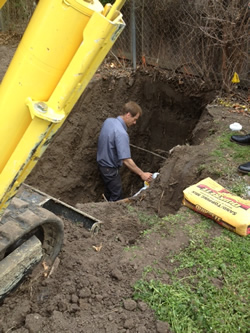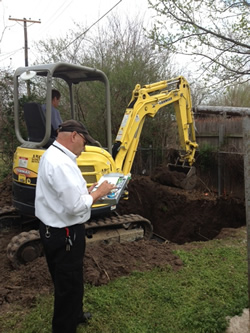Sometimes you just need to do some quick troubleshooting so you can at least know when to contact us and when to do a quick fix yourself. So here are a few common symptoms and solutions for quick reference:
Plumbing Emergencies: In a plumbing emergency, you'll need to stop the flow of water quickly. To do this, you and each member of your family needs to know the location of the shutoff valve for every fixture and appliance, as well as the main shutoff valve for the house, and how they operate.
If the emergency involves a specific fixture or appliance, first look for its shutoff valve and turn it clockwise to shut off the water to that fixture or appliance only.
The valve is usually located underneath a fixture such as a sink or a toilet, or behind an appliance, such as a clothes washer, at the point where the water supply pipe (or pipes) connects to it.
If the problem is not with a particular fixture or appliance, or if there's no shutoff valve for the fixture or appliance, use the main shutoff valve to turn off the water supply to the entire house.
In most homes, you should find the shutoff valve in the garage or where the water pipes enter the home.
Turn the valve clockwise to shut it off.
If valve is stiff enough that you should need a wrench to open it, you should keep one in close proximity to shut off.
If the main shutoff valve itself is defective and needs to be repaired, call Air Assurance; they can dispatch someone with the special tool that's required to shut off the water at the street.
Water Heater Leak:
- Turn off the Gas. (Twist the dial from "ON" to "OFF" position. For electric heaters, shutoff the breaker to the water heater)
- Turn off Water Supply. (Twist the handle clockwise until it stops. This is usually located at the top of the water heater. If this doesn't work, shutoff the main watershutoff valve to the house)
- Drain the Water Heater if Necessary to Avoid Water Damage. (attach garden hose to the drain valve normally located at the bottom of the tank. Run the other end of the hose to another lower area where dirty or rusty water won't harm plants or property, then open the hot side of inside faucets)
- On Models with a Relief Valve - (Pull the handle up to allow air to enter the heater)
- Call Air Assurance for Replacement or Repair Options
If you Smell Gas:
- Locate the Gas Meter outside the residence
- Turn Gas Valve 1/4 turn from "On" to "Off" position
- Call your Gas Utility Company, or Air Assurance for Emergency
Standing water in sink: If your disposal is gunked up, try running ice through it to clean the blades. If the blockage is in the P-trap underneath the sink, you're better off having us deal with the mess of fixing it. Don't pour corrosive cleaners down the sink!
Clogs: To help prevent clogs in the tub and shower, fit all your drains with a strainer that catches hair and soap build up, and clean the strainer regularly.
It is important not to rinse fats or cooking oils down the kitchen sink. These items may solidify in the cold pipes and create clogs.
Avoid using liquid drain openers (like Liquid Plumber or Drano) on a drain that is completely clogged. The acidic ingredients are trapped in your pipes, and it can cause severe damage to them. if you can't snake the drain yourself, contact a professional to do so.
Toilet won't flush properly or runs forever: Make sure the flapper is closing so the tank can refill, and that the chain connects the flapper to the ballcock. You might have clogged flush holes (under the toilet rim). If you have a broken flange or leaky wax ring at the base of the toilet, you'll probably want to let us fix that. You can check to see if your tank is leaking by putting some food coloring in the tank, and if you see food coloring seeping into the stool, you'll know there's a leak.
Toilet overflows: You can fix a one-time blockage with your trusty plunger or toilet snake, but it your toilet overflows regularly, get a plumber to inspect the pipes.
Low water pressure: You may have a broken water line. If the problem affects one room, the leak is probably in that part of the system; if it's house-wide, you should get the water line feeding the whole house checked. You can check your water meter and read the number and write it down. Turn all faucets, etc off, wait a couple of hours, then go and read the number again. If the number has changed, you probably have a leak somewhere. Smaller leaks may take longer to notice the number changing, so give it more time if possible.
Noisy water pipes: Pressure from your water heater could be causing your pipes to knock together if they've gotten un-fastened from the wall. We can attach new fasteners to brace them so they'll shut up.
"Rotten egg" smell: This could mean that a cracked vent pipe or drain is leaking sewer gas into your home. This is a job best left to the pros, so get out of that stinky house and contact us immediately.
Hope this is helpful!






